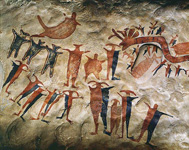звоните: +7 495 204-207-8
e-mail: art@quartagallery.ru
Recent posts
- Необычная судьба тверской художницы Наталии Пономаревой
- Жемчужина деревянной архитектуры русского севера
- Первая народная галерея в Льялово
- Online auction - a practical instruction. How to take part?
- История русской анимации и коллекционирование «истории» мультипликационных фильмов
- История в гравюрах и литографиях уникального печатного издания «Революционная Москва: Третьему конгрессу Коммунистического Интернационала». 1921
- Painting as a Gift
- What happened to frescoes of Kievskaya Metro Station?
Murals

Mural painting is artwork on architecture or other permanent base. The main technique of mural painting is a fresco which, together with mosaic and glass painting, is more frequently called monumental and applied art.
The tradition of painting walls and ceilings goes back a long time. Traces of house decoration culture involving artwork dates as far as the Paleolithic era. Very often it had sacred and ritualistic meaning. Many cave drawings have survived till modern times and have served as a source of inspiration for artists throughout the centuries.
When studying the history of ancient cultures we come across murals everywhere. They not only bring us joy but also tell about life, routines, labor and wars of the peoples of Ancient Egypt, India, China, Mexico and other countries.
The European history of monumental art starts with the development of Egyptian art (4-3 thousand B.C). Wall frescoes created in Egypt still win over hearts with their perfection and laconic character. Over centuries the technique of ornamental wall painting in Egypt was passed from generation to generation, thus forming the canon for depicting people, animals, various events, creating certain traditions and styles of depiction.
In Ancient Greece (end of 5–4 cc B.C.) art began to look for ways to express human feelings, heroic motifs intertwined with lyrics. The development of Roman culture boosted the development of architecture and interior design. Wall and ceiling painting acquired a more systemized character. Romans even used murals to decorate the facades of their buildings.
In the Middle Ages the growth in the influence of church on people's life also marked a new turn in the history of European art. Spiritual contents of the image were combined with décor and spiritual painting started its rapid development. Italy became the homeland of great architectural and art works, providing humanity with genius masters whose names and work fascinate us today. The term «fresco» is derived from Italian «affresco», which means «on fresh». The fresco - painting on fresh plaster - became the most popular wall painting technique. Before the beginning of the XVI century it was a common practice to paint details with tempera on dry «clean fresco», which required real mastership from artists. Soon painting on dry plaster «alfresco» emerged.
With time murals spread not only to temples but also to dwellings, and the subjects became more secular. The art of «alfresco» developed which imitated various types of decorative finish. There comes the revival of various trompe-l'œil paintings, false windows and doors popular yet in late Roman imperial period, which visually enhanced the interior. Such interior design is still popular in our times.
But the specific heyday of mural painting in the interior comes with the baroque period. Pompous decoration of chambers with their complex, ornate molding, was always accomplished with painted panels; diverse in the subject and complexity of plots they were invariably characteristic of such chambers.
The modern period mostly sees the development of graphic arts and murals take the backseat. The interior design is dominated by ornaments and intricate patterns. With the emergence of wallpaper frescoes become rarer and rarer as a type of wall finish.
However, in the USSR mural painting (along with other kinds of monumental art) moved from the private and church interior to factories and plants, Palaces of Culture, theater foyers, Metro station ceilings. Monumental art became a compulsory element of the whole art culture. It depended on the development of architecture and was closely related to it.
Nowadays mural painting develops both within the private and public interior, with the use of most contemporary materials and sometimes acquiring unexpected shapes, such as, for instance, art graffiti.
